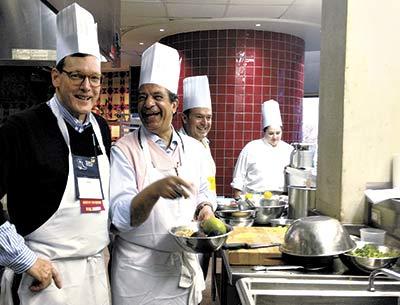Seasons by the Sea: A Cooking Boot Camp

I recently attended a C.I.A. boot camp, and golly did I learn a lot. And no, I’m not talking about the spy agency next to the house I grew up in in McLean, Va. It was the Culinary Institute of America campus in San Antonio, started in 2009.
Our group of club managers and hospitality professionals was randomly divided into two smaller groups. My foursome was put on the New Orleans Cajun and Creole food team. Having made enough étouffée, gumbo, popcorn rice, and bread pudding in my lifetime, I asked to be moved to the Latin cooking group, which they allowed. Each group was divided into smaller teams and tasked with a number of dishes that had to be ready for judging and sampling by 12:45 p.m. (We began this adventure at 8 a.m.) I was psyched; I just knew that my friend Ken’s and my team would win. Our team leader’s name was, I kid you not, King Hussein.
The New Orleans class was taught by Brannon Soileau, a real Louisianan chef. Our Latin team was led by Geronimo Lopez-Monascal, a chef from Venezuela. The New Orleans team was tasked with making crawfish étouffée, gumbo, fried oyster po’ boys, popcorn rice, and bread pudding. By my count, that’s five fairly simple dishes. The roux for étouffée does require some patience and finesse as it can take up to an hour to get the proper consistency, color, and flavor from the simple combination of flour and oil.
Our team made anticuchos de cordero, or lamb kebobs; arroz con pato, rice with duck; causa de cilantro y cangrejo, a Peruvian layered potato dish with crab meat and cilantro; shrimp ceviche with peanuts; traditional ceviche with leche de tigre; chupe de camarones, a thick, Peruvian crayfish stew; empanadas saltenas; solterito, a Peruvian fava bean salad; quinoa au gratin; salad de xuxu com palmito e laranja, made with chayote, hearts of palm, and orange, and tacu tacu, a bean and rice cake.
Now does that division of labor seem fair?
The two teams used two separate kitchens with cooking equipment located in between. Our team’s recipes hadn’t been Xeroxed yet, so we tried to work from one copy for about an hour and a half.
Restaurants and commercial kitchens use large containers of herbs and spices. A lot of us were using the same spices, but one person would take it to their station and hog it. I ever so helpfully filled up little “monkey dishes” (industry lingo for little cups for miscellaneous ingredients and condiments) and distributed them to each team.
We learned from our chef that the largest Japanese population outside of Japan resides in Peru, therefore having a great deal of influence on the cuisine, especially with ceviches that are seasoned more like sashimi and sushi. My task was to make the leche de tigre, a k a tiger milk sauce, for ahi tuna tiradito to be served on freshly fried yucca chips with a bit of mashed, salted avocado. Crikey, that sauce took me almost two hours to make! Rehydrated and drained bonito flakes, juiced limes, passion fruit, aji amarillo, and eight more ingredients. Maybe I’ve watched too many TV cooking competitions, but I was running around like a chicken with her head cut off.
King Hussein was a benevolent and patient leader; he calmly sliced the beautiful fresh tuna. Ken handled the quinoa gratinada all by himself. Nothing like dousing a healthy ingredient with cream, butter, and two kinds of cheese to make it taste better.
Once in a while I checked the other kitchen to see if they were scrambling and scurrying about like we were. No, they were chatting, steaming the rice, relaxing, tasting the roux, all while Chef Brannon regaled them with tales of the Bayou. Their kitchen was bigger and brighter and cleaner than ours, too. Gosh, I was jealous.
There were so many unusual ingredients and flavor combinations in our dishes. The condiments for an Ecuadorean shrimp ceviche were popcorn, peanuts, red onion, cilantro, and plantain chips. For some reason I never found out why the empanadas saltenas (Northern Argentine and Bolivian style) were made with expensive beef tenderloin.
When we were close to being finished with our dishes and ready to garnish for presentation, I snuck back over to the other team’s kitchen. At this point, they had flubbed up the creme Anglaise sauce for the bread pudding twice, and had started drinking the bourbon provided to flavor the sauce. Now I was doubly jealous.
The time came for the two teams to present and describe their dishes. The New Orleans group’s dishes were absolutely delicious. Who doesn’t like a fresh Gulf oyster deep-fried and slathered with remoulade sauce? But their food was essentially brown and tan and white, with a sprinkling of slivered scallions for a touch of green.
Our presentation, on the other hand, was a staggering array of colors and textures and flavors. I did mention that we made 10 dishes, right? Carved pineapples were pierced with lamb kebabs marinated in aji panco, rice cakes were topped with creamy crab meat, the salads of chayote and fava beans and hearts of palm sparkled with citrus brightness.
Which team won? Well, it seems that the whole team-building-competition aspect of the day got forgotten somewhere along the line, but I’m pretty sure it was King Hussein’s industrious little group. Here are a few of the recipes from this wonderful, educational, but totally unfairly divided Latin Cooking Boot Camp.
Click for recipes
